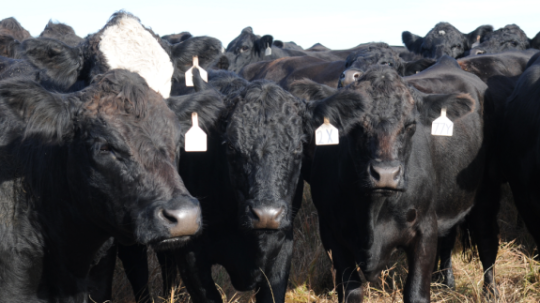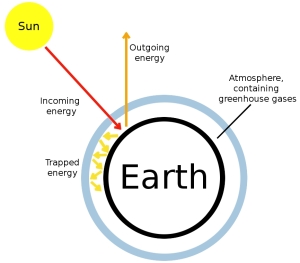Tagged: greenhouse effect

Human Influences on Greenhouse Effect: Grade 9 understanding for IGCSE Biology 4.13 4.14 4.15
I established in a previous post that the Greenhouse Effect is a good thing for life on the planet. So what is the problem? Well the simple idea is that human activities and the massive growth in human populations seen over the past two hundred years have changed the composition of the atmosphere. The concentration of greenhouse gases has risen and this enhanced greenhouse effect is causing climate change.
The principal gases in the atmosphere responsible for the greenhouse effect are carbon dioxide, methane and water vapour. Have a look at these two tables taken from the following website from the Center for Climate and Energy solutions:
http://www.c2es.org/facts-figures/main-ghgs
The first image shows the main gases in the atmosphere that contribute to the Greenhouse Effect.

Anthropogenic means “caused by mankind” and so you can see what humans are doing to generate an enhanced greenhouse effect. The GWP figure stands for Global Warming Potential and gives a relative value for how each gas might contribute to climate change. One molecule of CFC-12 is as powerful as a greenhouse agent as 10,900 molecules of carbon dioxide.

This second table shown above demonstrates how the composition of the atmosphere has changed from pre-indutrial to modern times. I am going to focus on the two greenhouse gases at the top of the list: carbon dioxide and methane.
Carbon Dioxide concentrations in the atmosphere
Scientists at the Maunua Loa Observatory in Hawaii have been measuring atmospheric carbon dioxide concentrations since the 1950s. Here is a graph of their results.

What do you notice about this graph?
- There is a gradual upward trend such that the average concentration has risen steadily over the 50 year period.
- Within each year, there is an annual peak and an annual trough in the carbon dioxide concentration. The “peak” corresponds to northern hemisphere winters when there is less photosynthesis by plants and more fossil fuels are burned. The “trough” is northern hemispere summer when photosynthesis rates are high and so carbon dioxide is removed from the atmosphere
If you want data going back further into the past, you need to look at ice core data. Tiny volumes of the atmospheric gases are trapped within ice as it forms in Antartica and by drilling out a core and analysing the gases it contains, one can determine the concentration of the atmosphere when the ice was formed. The deeper parts of the core formed longer ago so a journey through an ice core is like travelling back in time…..
What human activities might be responsible for these changes in carbon dioxide?
- Deforestation (see my post on this topic)
- Combustion of Fossil Fuels (coal, oil, gas)
- Cement production
Methane concentrations in the atmosphere

Methane is also a potent greenhouse gas. It is produced as waste product of the bacterial reactions that happen inside the rumen and intestines of cattle. (The rumen is the large first chamber of their stomach in which bacteria digest cellulose in the cow’s food) I was once told that each cow produces 65 litres of methane a day but I have never measured it myself……. Seeing as the world population of cattle is estimated at 1.4 billion, that is a lot of methane each day being released into the atmosphere.
Methane is also produced by bacteria that break down our domestic waste in land fill sites and by anaerobic bacteria that live in paddy fields in which rice is grown. More humans means more cattle, more rice and more landfill and all of these are responsible for the rise in methane concentrations seen in the atmosphere in recent times.

Greenhouse Effect: Grade 9 understanding for IGCSE Biology 4.13 4.14 4.15
The Greenhouse Effect is the name given to the way in which the earth’s atmosphere acts to warm up the planet. The earth and the moon gain almost exactly the same incident radiation from the sun and yet average temperature on the earth is stable at around 14 degrees Celsius. On the moon the temperature fluctuates wildly from 1oo degrees Celsius during the day to minus 153 degrees Celsius at night. Life would be impossible in such extreme and variable conditions and so the greenhouse effect is definitely a “good thing” for life on our planet.
How does the greenhouse effect work?
Well the main idea here is that there are certain gases in the atmosphere that can trap the infrared radiation that the earth emits and prevent it escaping the atmosphere. These greenhouse gases are warmed as they absorb the infrared and so the atmosphere heats up.

Remember that because the sun is so hot, it emits radiation at a much higher frequency. This is mostly in the “visible light” part of the spectrum together with some ultraviolet. The gases in the atmosphere cannot trap visible light (air is transparent as you have probably noticed) and so most of the solar radiation passes through the atmosphere and hits the earth.

Which gases can act as greenhouse gases?
The two most prevalent gases in the atmosphere are nitrogen (N2) and oxygen (O2) and neither is able to trap infrared so cannot act as a greenhouse gas. The principle greenhouse gases in the atmosphere are

- carbon dioxide
- water vapour
- methane
- ozone
- nitrous oxide
So what’s the problem?
Well of course the problem is that human activities over the past century or so have altered the composition of the atmosphere so that the concentration of greenhouse gases has risen. This has meant more heat is trapped and climate systems are altered in consequence. This enhanced-greenhouse effect is the problem and I will look at this in the next post…..


Evidence for Climate Change: Grade 9 understanding for IGCSE Biology (part 2) 4.13 4.14 4.15
Before you can look at the science of climate change and how human activities are causing it, you first need to accept that we are currently undergoing a period in which our climate is changing at an unprecedented and rapid rate.
What would you expect to see in a warming world?

Well the first and most obvious point is that you would expect to see measurable changes in land and sea temperatures.
The top ten hottest years on record have all happened since 1998.

There is excellent evidence from all over the planet of glaciers shrinking; polar ice caps are shrinking and it may be that the North Pole is free of summer sea ice for the first time in 100,000 years some time in the coming decades. (This is controversial as it is a prediction based on computer models of future climate: different models make different predictions and with a system as chaotic and interwoven as global climate, it can be very difficult to predict)
As the oceans have warmed, this has impacted on extreme weather systems. This graph shows the incidence of North Atlantic Tropical Storms over the past century or so. It has continued to rise since 2007…..

When you look at all this evidence, it is hard to believe that our climate has been stable over the past century. In fact very few people try to dispute the fact of climate change. The dispute is whether human activities are causing this climate change and indeed whether it matters….. I hope in later posts I can convince you the answers to these two questions are yes and yes.

Air pollution and climate change: Grade 9 understanding for IGCSE Biology (part 1) 4.13 4.14 4.15
Climate change remains one of the more controversial topics in the IGCSE Biology specification. Just in the past few weeks, the USA (one of the finest nations on the planet) has elected as their President someone who has stated on record that he believes in some giant conspiracy theory about climate science centred around the Chinese….

The overwhelming majority of climate scientists do not support this interpretation of the facts. They are able to provide evidence of rapid climate change over the past few decades and link this to human-induced changes in the composition of the atmosphere due to pollution. When these facts are linked by a sensible scientific theory that proposes how and why certain gases might lead to an increased warming effect in the atmosphere (the so-called greenhouse effect) the evidence in support of human-induced climate change becomes compelling. Keeping US manufacturing competitive is important of course, but not at the expense of the enormous environmental and financial costs of allowing our pollution of the atmosphere to continue unchecked. I am not sure I will be able to convince President-Elect Trump (he probably doesn’t read my blog in any case) but perhaps I can show you the kind of understanding needed to generate A* answers in GCSE questions on this topic…?

I am going to organise this work into several sections and will post on each topic in the coming week….
- What is the evidence for climate change?
- What is the greenhouse effect?
- How are human activities altering the make up of the atmosphere?
- What are the predicted consequences of climate change in the coming years?




